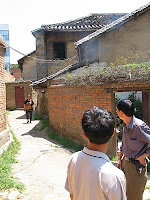Historical Cognitive Ethno-Fashion, and Friday 10:03
Saturday, January 12, 2008
One benefit of raising five children is that as they each venture in directions I have never gone, I am the richer for it. For example, my computer-tech sons keep me up-and-running and challenge me to stay current. My two children who have married Brazilians have introduced me to a wonderful country (and a language) I had hitherto pretty much ignored. (Now, my quasi-citizenship-by-inlawhood is turning to China, though that country has long fascinated me.) My daughter who has focused on Peace Studies and solutions for domestic violence has challenged me in that direction. The daughter who has been working with a ministry to the differently-abled is now beginning a masters degree in Spiritual Formation and Leadership. Two of my children have chosen liturgical churches far different from the Evangelical tradition in which I raised them. Etc.
Cognitive Science is a branch of learning I only became aware of as two of my children took it up. I have never had it explained to me the same way twice, but it basically comes down to trying to figure out how the brain works. So for my son who studies Cognitive Linguistics, the question becomes, “How does the brain do language?” For my son who studies Cognitive Ethno-Fashion, the question is, “How does the brain work in cultural ways to do clothing and adornment?”
This last item became important to me this week as I worked on my novel. In discussing literary genres, the imaginary line between ‘Historical’ and ‘Contemporary’ falls somewhere around 1950. At the time I began my novel, it was plainly Contemporary. Forty years later as I strive to finish it, I’ve come to consider 1966 as Historical. About ten days ago, I decided to include a cameo appearance by James Pike, then the controversial Episcopal Bishop of California. I turned to my Cognitive Ethno-Fashionologist son, who happens also to have ambitions toward the Episcopal priesthood, and we have studied photographs of Bishop Pike and the fashion choices then available to an Episcopal bishop. I have learned far more than I could ever use in a cameo appearance, but it has been a marvelous opportunity to go back in history and visit another world with my son as tour-guide. I think readers will also enjoy the cameo.




